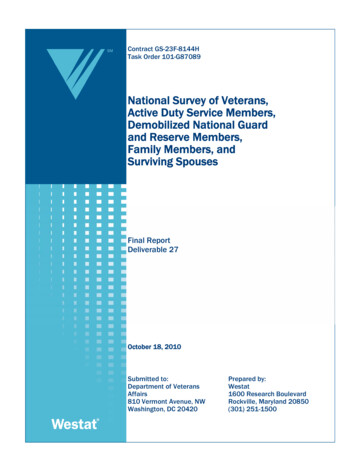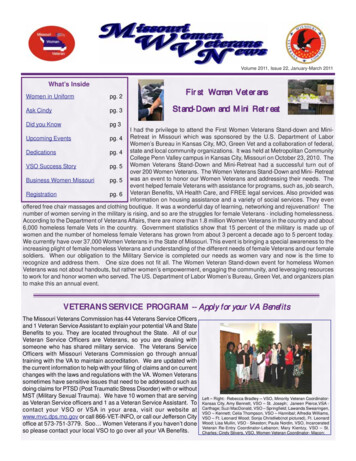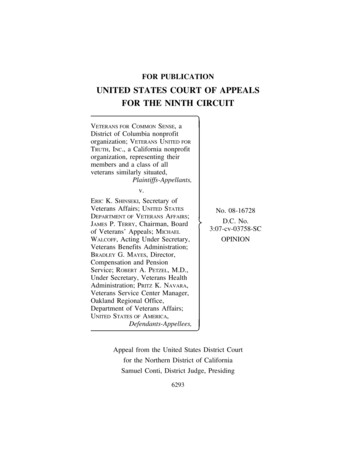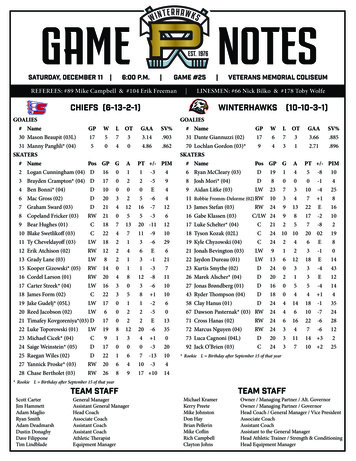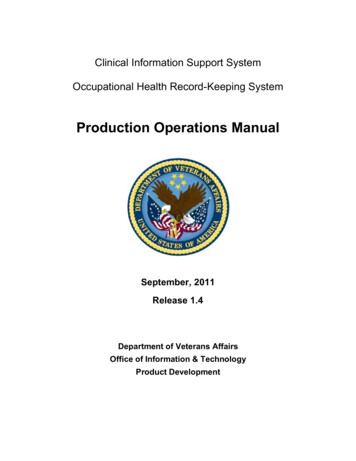
Transcription
Clinical Information Support SystemOccupational Health Record-Keeping SystemProduction Operations ManualSeptember, 2011Release 1.4Department of Veterans AffairsOffice of Information & TechnologyProduct Development
Revision .21.31.41.51.41.41.41.41.41.4Initial documentTechnical editAdditional ContentTechnical editTechnical editTechnical REDACTED
Table of Contents1.2.3.Introduction . 11.11.21.31.41.4.1Summary . 1Purpose . 1Scope . 1Related Documents and Agreements. 1Memorandum of Understanding (MOU) . 11.4.2Service Level Agreement (SLA) . 21.4.3Service Level Requirements (SLR). 21.4.4Operational Level Agreement (OLA) . 21.4.5Operations and Maintenance Plan (O&M). 21.4.6Underpinning Contract . 21.5 Section Summary . 3System Business and Operational Description . 32.12.22.32.42.4.1Operational Priority and Service Level . 4Logical System Description . 4Physical System Description . 4Software Description . 6Background Processes. 72.4.2Job Schedules – (Reference Background Processes) . 82.5 Dependent Systems . 9Routine Operations . 93.1 Administrative Procedures . 103.1.1System Start-up . 103.1.1.1Windows Database Server . 103.1.1.2Linux Web server . 103.1.1.3Linux Application server. 113.1.2System Shut-down . 123.1.3Back-up and Restore . 153.1.3.1Back-up Procedures . 153.1.3.2Restore Procedures . 163.1.3.3Back-up Testing . 163.1.3.4Storage and Rotation . 163.2 Security / Identity Management . 173.2.1Identity Management . 173.2.2Access control . 17
3.3 User Notifications. 18Table of Contents3.4 System Monitoring, Reporting & Tools . 183.4.1Availability Monitoring . 194.3.4.2Performance/Capacity Monitoring . 203.4.3Critical Metrics . 213.5 Routine Updates, Extracts and Purges. 213.6 Scheduled Maintenance . 223.7 Capacity Planning. 22Exception Handling . 224.1 Routine Errors . 224.1.1Security . 224.1.2Time-outs . 224.1.3Concurrency . 234.2 Significant Errors . 234.2.1Application Error Logs . 234.2.2Application Error Codes and Descriptions. 234.2.3Infrastructure Errors . 234.2.3.1Database . 234.2.3.2Web Server . 244.2.3.3Application Server . 244.2.3.4Network. 244.2.3.5Authentication & Authorization . 244.3 Dependent System(s) . 254.4 Trouble Shooting . 254.5 System Recovery . 254.5.1Restart after Non-Scheduled System Interruption . 254.5.2Restart after Database Restore . 255.Continuity of Operations . 256.Disaster Recovery . 256.16.26.36.46.56.66.76.8Required: . 26Assumptions: . 26Web/Apache server (Falling Waters) . 26WebLogic server (Falling Waters) . 27Database server (Falling Waters) . 27Database server (Hines). 29Web/Apache server (Hines) . 29WebLogic server (Hines) . 30
7.6.9 Load Balancer (Hines). 30Table of ContentsSystem Support . 327.1 Support Structure . 327.1.1Support Hierarchy . 327.1.2Division of Responsibilities . 327.2Support Procedures. 33
CISS/OHRS Production Operations ManualSeptember, 20111. Introduction1.1SummaryA Production Operations Manual (POM) defines the specific technical and operational processes thatmust be carried out on a daily, weekly, monthly, or yearly basis. A POM is an application/system-specificdocument containing detailed topology, dependencies, monitoring specifics, maintenance windows, etc.Additionally, it contains the system’s scheduled events (regular production jobs, performance reporting,or maintenance windows, etc.). The POM provides Field Operations staff the necessary instructions tooperate and support production computer systems.The production support for the System Name Production System is divided or shared between theEnterprise Operations & Infrastructure (EOI) and Product Development within the Office of Information& Technology (OI&T), and Corporate Data Center Operations (CDCO).1.2PurposeThe purpose of this document is to: Be used as a reference manual for the daily operation and maintenance of CISS/OHRSAssist support personnel on the resolution of system issuesAssist in the capacity, maintenance, and upgrade planning of CISS/OHRS1.3Scope1.4Related Documents and AgreementsThe scope of this document is limited to CISS/OHRS. Any references to external systems is only fordescribing an interface and how the interface and the external system affects the operation of CISS/OHRSor as a tool that may be used as part of system monitoring or the support and issue resolution system.The VA Service Level Management Board (SLMB) has developed a memorandum that standardizesterminology and definitions for key documents used for implementation, operation, and monitoring ofservices provided by OI&T. The primary documents are Memorandum of Understanding (MOU), ServiceLevel Agreement (SLA), Service Level Requirements (SLR), Operational Level Agreement (OLA),Operations and Maintenance (O&M), and Production Operations Manual (POM). The purpose andrelationships of these documents are summarized below.1.4.1 Memorandum of Understanding (MOU)The Memorandum of Understanding (MOU), a written agreement between an OI&T service provider andcustomer(s), documents the services that each party will provide for a program or service. The MOU isthe foundation document upon which the SLA, O&M Plan, and others are built. The MOU is a strategicdocument, whereas the SLA, O&M, and POM are more functional/tactical documents.The MOU serves as the signatory document that invokes the SLA. The SLA/SLRs are referenced in theappendix of the MOU, allowing them to be managed or modified without renegotiating the entire MOU.1
CISS/OHRS Production Operations ManualSeptember, 20111.4.2 Service Level Agreement (SLA)A Service Level Agreement (SLA) is a consolidated mutual agreement between a service provider andcustomer(s) that documents and describes agreed levels of performance and availability. The SLAdescribes Service Level Targets (SLTs), key performance indicators, monitoring approach, and a processfor managing the service levels. In the VA, all SLAs are approved, negotiated, and governed through theService Level Management Board (SLMB).1.4.3 Service Level Requirements (SLR)In the VA, Service Level Requirements (SLRs) are a list of basic performance measurementrequirements. A SLR is proposed by the customer and negotiated with OI&T to reach a good faithagreement on the acceptable level of service and the metrics to monitor the service. The SLR is a servicespecific breakdown (usually in a table) in an SLA appendix with a unique name and number.After the SLR is negotiated, it results in an agreed Service Level Target (SLT) with metrics, measurementtechniques, and assumptions. The SLA and SLTs are a combined document.1.4.4 Operational Level Agreement (OLA)An Operational Level Agreement (OLA) is an agreement between two or more OI&T entities thatdocuments agreed service levels for general performance or critical services. An OLA is very similar to aSLA except that it is internal to OI&T functional units. An OLA defines specific key performanceindicators and related metrics to measure success criteria. OLA metrics should form the foundation uponwhich SLA metrics can be derived for customer-facing services.1.4.5 Operations and Maintenance Plan (O&M)The Operations and Maintenance (O&M) Plan defines the operational support tasks and activities thateach of the Office of Information & Technology (OI&T) functional areas are required to provide in thedelivery and support of a production enterprise system. The O&M Plan defines specific roles andresponsibilities of OI&T functional support teams to avoid confusion over which party is responsible forspecific areas of process, tasks, or actions. The O&M plan supports the specific service levels for eachactivity as defined in the Service Level Agreement (SLA), describes how performance is measured, andidentifies the responsible entities for each activity.All key functions are assigned to one or more responsible parties and activities are clearly defined inorder to maintain and support the applications and system components throughout its life cycle. Theseroles and responsibilities are displayed in a tabular RACI format at the end of each section of the plan tofurther define Responsibility, Accountability, Consultation, and Information roles.1.4.6 Underpinning ContractUnderpinning Contract is an agreement between an IT service provider and a third party, includingvendors, that provides goods or services that support delivery of an IT service to a customer. It isdeveloped either by the Program Office or OI&T, depending on ownership of the budget/funds2
CISS/OHRS Production Operations Manual1.5Section SummarySection1. Introduction2. System Business andOperational Description3. Routine Operations4. Exception Handling5. Continuity of Operations6. Disaster Recovery7 System SupportSeptember, 2011SummaryThis section describes the scope and purpose of the document,along with other relevant documents.This section provides the reader with a description of thesystem. It describes what the system does in the context of theVA.This section describes what is required of anoperator/administrator or other non-business user to maintainthe system at an operational and accessible state.This section gives an overview of how system problems arehandled. It should describe the general expectations of how theadministrator and other operations personnel should respondand handle system problems.This section describes the processes or procedures thatoperations personnel need to execute in order to fulfill theirresponsibility in the systems Continuity of Operations plan(COOP).This section describes the processes or procedures thatoperations personnel need to execute in order to fulfill theirresponsibility in the systems Disaster Recovery (DR) plan.This section describes the VHA system support structure andhow to use it to resolve system problems.2. System Business and Operational DescriptionThe Clinical Information Support System (CISS) project is a HealtheVet initiative from the VeteransProgram portfolio. It is a Web-based portal application that provides a central interface for users to accessinformation and applications necessary for their roles. The applications accessed through CISS are calledpartner systems. The initial CISS partner system is the Occupational Health Record-keeping System(OHRS), a Web-based application that enables occupational health staff to create, maintain, and monitormedical records for VA employees and generate national, VISN, and site-specific reports.While implementing the CISS framework and the OHRS application, the CISS project team follows anagile software methodology to support rapid programming and short six-month releases to production.For more information please view the Agile Software Development Methodology and other documentsavailable on the CISS TSPR asp?proj 1256&Type Active).This document contains instructions to help System Operators administrate and troubleshoot the deliveredsoftware. System Operators are defined as IT staff at the data centers where CISS is deployed.3
CISS/OHRS Production Operations ManualSeptember, 20112.1Operational Priority and Service Level2.2Logical System Description2.3Physical System DescriptionThe CISS project is a 24x7 system.Intranet access to the application is achieved from the customers’ web browsers to a URL addressassociated with the Load Balancer’s Virtual Server. Connectivity is directed to the CISS web servers,with the exception if requesting the Web-based content-sensitive help; all other traffic is redirected to theWebLogic application servers and their configured server ports. The CISS login portal webpage interactswith the VA Lightweight Directory Access Protocol (LDAP) service to determine access to the portal andany partner applications. Once access is gained and the OHRS partner application button is accessible, theOHRS application may be launched. OHRS application saves data into a local database and certainfunctions require interactions between the VistA systems of the chosen Site.The CISS servers consist of six physical servers, consisting of two Web servers, two Applications servers,and two Database servers. Redundancies are achieved through multiple methods: Replication of data atthe OS and Application levels.The architectural design of each of the three groups consists of different redundancies: The database servers are to be clustered at the OS level and at the database application level. Thedatabase servers are connected to a SAN, for additional storage, redundancy, and availability.The two web servers are designed to run exactly the same functionally, through non-clustered. OSlevel synchronization keeps the two servers consistent.The two application servers are not clustered at the OS level, but are clustered at the Applicationlevel. OS level synchronization and application implemented clustering maintain the redundancies.The Current systems implemented are HP ProLiant DL380 G5 servers, Intel Xeon CPU E5420 @2.50GHz 64 Bit Dual Quad core Processors, Dual Power Supplies, Dual Gigabit Network interfaces,iLO2 – Integrated Lights Out management port, RAID-controlled 6 HDD, 16 GB Memory. MicrosoftWindows 2003 Enterprise and Red Hat Enterprise Linux 5.x are the Operating Systems of the systems.All Systems are attached to sites Gb network. ILO’s have not yet been implemented; initially the Coreswitches did not have enough available ports.Six of the Servers reside at Falling Waters, WV (CDCO), the Production site. Seven other Servers arelocated at Hines, IL. The Hines site is considered the Disaster Recovery (DR) site.Main difference between the 2 data centers are:The Hines, IL data center’s initial implementation did not have the SAN storage available to attach to thedatabase servers; the database servers alternative was to run using their local storage and leveragemirroring between the two database servers. Another difference is the additional MS Windows server asthe MS SQLServer “Witness” server. The “Witness” server monitors the two Hines database servers, anddelegates which server is the Primary and the other as the Stand-by nodes.4
CISS/OHRS Production Operations ManualSeptember, 20115
CISS/OHRS Production Operations Manual2.4 September, 2011Software DescriptionThe Operating Systems:Microsoft Windows 2003 Enterprise Edition x 64 BitRed Hat Enterprise Linux 5 x 64 BitThe Applications: BEA / Oracle WebLogic 10.3.2 Microsoft SQLServer 2005 Apache 2.2.3 VistALink 1.5File system sizes differentiate between the Servers Functions: Windows servers Database servers6
CISS/OHRS Production Operations ManualSeptember, 2011Local Drives C: 40 GB D: 96 GB E: 292 GB F: 254 GBo SAN Attached ( If attached, and if the Active server in the Cluster ) G: 102 GB H: 102 GB J: 102 GB L: 34 GB M: 17 GB O: 85 GB Q: 500 MBRHEL Application server992M /o /dev/mapper/rootvg-root3.9G /opto /dev/mapper/rootvg-opt3.9G /varo /dev/mapper/rootvg-var3.9G /tmpo /dev/mapper/rootvg-tmp3.9G /usro /dev/mapper/rootvg-usr2.0G /homeo /dev/mapper/rootvg-home251M /booto /dev/cciss/c0d0p17.9G /dev/shmo tmpfs97G/u01o /dev/mapper/rootvg-u019.9G /u02o /dev/mapper/rootvg-u029.9G /u03o /dev/mapper/rootvg-u03o /dev/mapper/rootvg-u049.9G /u04o Example: Mounted Network File Share Listed ere are numerous scripts involved in monitoring and synchronizing of servers systems.2.4.1 Background ProcessesThe Microsoft SQLServer runs a Daily “Maintenance Plan”: Maintenance Clean up on Local server connection Clean up Database Backup filesClean up history on Local server connection History type: Backup, Job, Maintenance PlanBackup Database on Local server connection: CISS, Model Databases - Transaction LogsCheck Database integrity on Local server connection: CISS,CISS distributor,master,model,msdbUpdate Statistics on Local server connection: CISS,CISS distributor,master,model,msdb7
CISS/OHRS Production Operations Manual September, 2011Backup Database on Local server connection: CISS,CISS distributor,master,model,msdbReorganize index on Local server connection: CISS TablesThe SQL backups are stored on the mapped H: SAN attached drive. The database servers have OS levelbackup run at 5:00 A.M. every day. The DOS batch script does a checksum of the last backups, XCOPYof the files to the DR servers, purges any files that are over five days.The Linux servers, application, and web servers each have scheduled jobs:The web servers monitor any PAID files that arrive and rename the file with a Date/Time stamp. Ifprocessed files are found, after OHRS has uploaded the PAID content into the OHRS database, the filesare TAR GZIP’d into an archive file.Example Crontab:#*****[command to be executed]## # ----- day of week (0 - 6) (Sunday 0)# ------- month (1 - 12)# --------- day of month (1 - 31)# ----------- hour (0 - 23)# ------------- min (0 - 59)*/10 ****/bin/bash /usr/local/bin/cissPAID update filename.bshAlso the Web servers monitor, Similar Process with VAADERS data.( Scripts / Process still pending )2.4.2 Job Schedules – (Reference Background Processes)UNDERLINED TEXT is the User and its ########################The Following is a Description on the Crontab ########################*****#-----# # ----- day of week (0 - 6) (Sunday 0)# ------- month (1 - 12)# --------- day of month (1 - 31)# ----------- hour (0 - 23)# command to be executedmin (0 - 59)8
CISS/OHRS Production Operations ManualSeptember, 2011ROOT -- Webservers###Setting up for later the retrieval of new Files#38,10,12,14,16,18 **/usr/local/bin/OFA sftp retrieve.bsh###For OFA samba share1,2,3,4,5bashwith samba up.html*/15-22***/bin/bash /var/www/cgi-bin/SAMBA update.bsh -C10***/bin/bash /var/www/cgi-bin/SAMBA update.bsh -R**PBM -- Webservers*/10**/bin/bash /app/bea/weblogic/domains/CISSDomain Prod/bin/check vlj connectors.bsh14**0,3/bin/bash /usr/local/bin/CG Prod.bsh -E PRD*/4**** ions.py /ciss.properties /dev/null 2 &127*** domains/CISSDomain Prod/WLST scripts/vljMonitor.pyciss.properties ALL2.5Dependent SystemsSystems on which CISS/OHRS are dependant: VistAlink connectivity to each VA VistA systemPersonnel and Accounting Integrated Data System (PAID) -- Receive automated uploaded filesVAADERS – Receive manually uploaded filesOther Federal Agencies (OFA) – This Process has been put on hold.Standard Data Service (SDS)3. Routine OperationsUsing Linux bash scripts to extract data from the different servers and systems, the data is gathered,parsed, and output in csv, xml, flat file, or direct to the email. The systems administrator will monitor theWebLogic JVM - Java Virtual Machine Memory, File System usages, VistALink Adaptor connectivityvia Dashboards, Consoles, or received emails. The systems administrator will also deploy the newartifacts during planned outages, stop and start the WebLogic managed servers, monitor system backups.Routine OS patches, updates will be performed via mechanisms standard to the OS.9
CISS/OHRS Production Operations ManualSeptember, 2011The database administrator will monitor database growth, replication, and backups. The databaseadministrator will perform updates, upgrades, and maintenance to the database or database engine.3.1Administrative Procedures3.1.1System Start-up3.1.1.1 Windows Database Server Once the server is powered on, the SQLServer database instance for CISS will automatically start. Toverify service is running, open the Windows ‘Services,’ locate the following: o SQL Server (PROD SQLSERVER)o SQL Server Agent (PROD SQLSERVER)o SQL Server Browsero SQL Server FullText Search (PROD SQLSERVER)o SQL Server Integration Serviceso SQL Server VSS WriterLog into SQL Server Management Studio to confirm SQL server database is up and running and thatyou can connect to the database.The 5:00 A.M. backup is an OS level scheduled task.3.1.1.2 Linux Web server: Once the server is Powered on, check the Network File Share (nfs) and Apache web services (httpd),and Very Secure File Transfer Protocol ( vsftpd ) services are running:oSudo to the Root (Super User):oCheck that the nfs service is Running:sudo su –service nfs status;If Not running, start the service:service nfs start;chkconfig --level 234 nfs on;oCheck that the httpd is runningservice httpd status;If Not running, start the service:oooservice httpd start;chkconfig --level 234 httpd on;Check that the vsftpd is runningservice vsftpd status;If Not running, start the service:10
CISS/OHRS Production Operations ManualooSeptember, 2011service vsftpd start;chkconfig --level 234 vsftpd on;3.1.1.3 Linux Application server: Once the server is powered on, the WebLogic Node manager must be started.oSudo to the weblogic user:oStart the nodemanager and background the Process:sudo su – weblogic3 ;bash nodemanager/startNodemanager.sh &Allow the nodemanager to start, check by verify the port 5556 is listening, run the lsofcommand:o /usr/sbin/lsof -Pni grep weblogic grep LISTEN ;Start the WebLogic Administrative Console:ooo bash CISSDomain/startWeblogic.sh &Watch for the following text in the output sent to the screen. Server state changed to STARTING Server started in RUNNING mode Verify the Admin server started by either the following methods:Opening a web browser to the http://vaww.ciss.REDACTED/console cd {HOME};getstatus.sh ciss.properties ; Run the getstatus.sh script:Run the
1.4.2 Service Level Agreement (SLA) A Service Level Agreement (SLA) is a consolidated mutual agreement between a service provider and customer(s) that documents and describes agreed levels of performance and availability. The SLA describes Service Level Targets (SLTs), key performance indicators, monitoring approach, and a process


